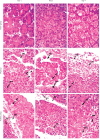Remote effect of kidney ischemia-reperfusion injury on pancreas: role of oxidative stress and mitochondrial apoptosis
- PMID: 27186168
- PMCID: PMC4848349
- DOI: 10.5114/aoms.2015.48130
Remote effect of kidney ischemia-reperfusion injury on pancreas: role of oxidative stress and mitochondrial apoptosis
Abstract
Introduction: Recent studies have demonstrated remote effects of renal ischemia/reperfusion (IR) injury on some organs such as brain, liver, and lungs. Oxidative stress is reported to be the cornerstone in such ischemic conditions. Associated apoptosis is also reported in remote lung, liver and myocardial injury after acute kidney injury. So, we postulated that renal IR may affect the pancreas by its remote effect. Oxidative stress and mitochondrial mediated apoptosis may play a crucial role in this injury. We investigated the effects of kidney IR on pancreatic exocrine and endocrine functions, antioxidant enzyme activity, and apoptosis.
Material and methods: The protective effect of vitamin C was also investigated. The animals were submitted to non-traumatic bilateral renal IR, sham operation or treatment with vitamin C after IR. Rats were sacrificed on the 1(st), 3(rd), and 7(th) days of the experiment to evaluate the parameters of oxidative stress (catalase, lipid peroxidase, reduced glutathione and superoxide dismutase), pancreatic endocrine and exocrine function (amylase, insulin and fasting blood glucose), renal functions (serum creatinine and blood urea nitrogen), cellular injury and apoptotic markers (Bcl-2, Bax and caspase-3).
Results: Kidney I/R significantly increased the renal and pancreatic functions at 1, 3 and 7 days, while fasting insulin was significantly increased at day 3 after ischemia. Moreover, I/R significantly increased the studied oxidative stress markers and decreased the antioxidant capacity in pancreatic tissues. In addition, renal I/R induced numerous histopatological lesions in pancreatic tissues and increased the apoptosis-related genes. Treating the rats with vitamin C (100 mg/kg) significantly restored the renal and pancreatic functions, improved the pancreatic antioxidant capacity and protected the pancreatic tissues from apoptotic necrosis.
Conclusions: The results suggested that bilateral renal ischemia for 45 min caused significant impairment of pancreatic function and structure as indicators of acute pancreatitis. While IR enhances oxidative stress and apoptosis, vitamin C appears to play a cytoprotective role.
Keywords: kidney ischemia-reperfusion; oxidative stress; pancreatic apoptosis.
Figures




References
-
- Bulent G. Ischemia reperfusion injury in kidney transplantation. 2011. Available at: http://www.intechopen.com/books/kidney-transplantation-new-perspectives/....
-
- Hussein A, Abd-Elkhabir A, Abozahra A, et al. Pancreatic injury secondary to renal ischemia/reperfusion (I/R) injury: possible role of oxidative stress. Physiol Res. 2013;63:47–55. - PubMed
-
- Marian V, Dieter L, Jan M, Mark T, Milan M, Joshua T. Free radicals and antioxidants in normal physiological functions and human disease. Intern J Biochem Cell Biol. 2007;39:44–84. - PubMed
-
- Hengartner M, Bryant J. Apoptotic cell death: from worms to wombats… but what about the weeds? Symp Soc Exp Biol. 2000;52:1–12. - PubMed
LinkOut - more resources
Full Text Sources
Other Literature Sources
Research Materials
Miscellaneous
